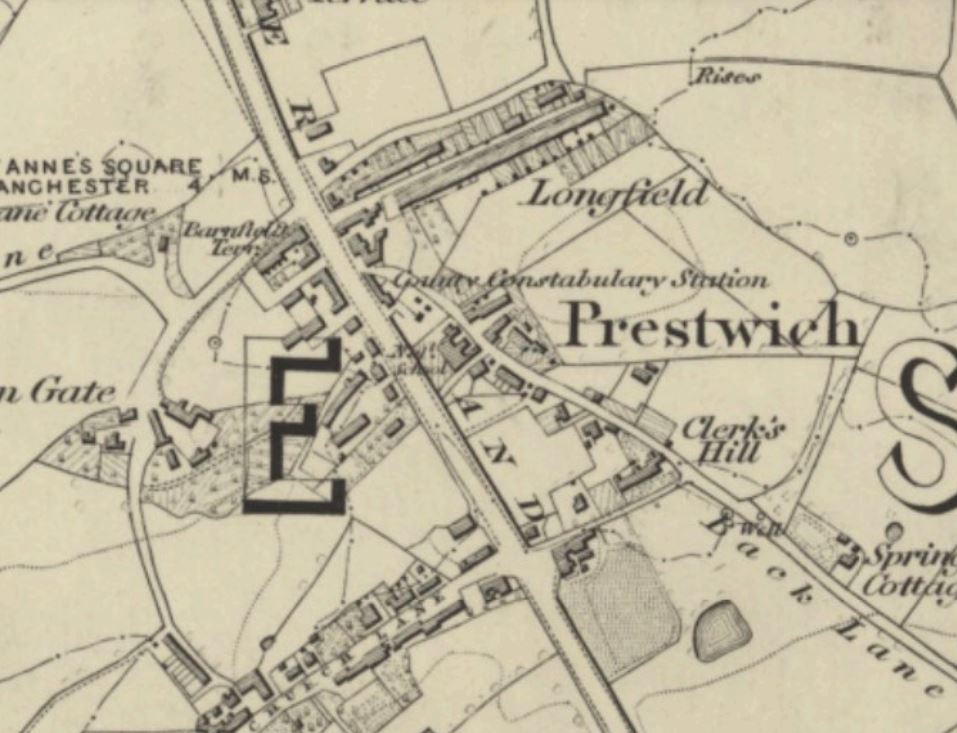One of the things that came out loud and clear during our conversations with local people was how important it is for the Prestwich regeneration plans to complement the village’s heritage and character.
From the very start of the project the design team worked hard to get under the skin of the local area and study the character, materials and architecture of surrounding buildings and local heritage.
And there’s lots of heritage and character to draw inspiration from! Here, we take a dive into Prestwich’s past and look at how this has inspired the future.
The growth of the Prestwich we know today
In the 17th and 18th centuries, Prestwich was a rural backwater, lightly populated around the church, with a network of narrow country lanes and farm tracks. After Bury Old Road was created in 1754, Prestwich soon became a centre of weaving manufacturing before the industry started to decline as factories were built in the area. Bury New Road’s arrival in 1828 saw Prestwich transformed from a quiet village into a suburb of Manchester, with its own High Street.
The advent of the railway in 1879 saw an influx of more affluent merchants starting to move into the village with several new housing neighbourhoods to boot. From 1912 to 1961, the population more than doubled (from 12,800 to 31,000), as Prestwich became the place we know and love today.
The Longfield Centre is in one of the oldest parts of Prestwich. ‘Longfield’ was possibly the earliest street in the village and ran roughly east-west across the centre of the site.
The village’s most notable buildings and dominating architectural character are post 18th century … think Victorian terraced houses, pubs, re-purposed banks and other public buildings.
Red brick is everywhere in the village centre with lots of ingenious detailing – cornices, arches, flat arches, textured gables and ornate chimneys are just a few of the exuberant architectural details created in brick by the Victorian architects. Buildings such as Our Lady of Grace RC Church and Prestwich Liberal Club, with their sandstone and terracotta detailing, are two great examples of some of the special buildings in Prestwich, but there are many more.
But history is more than bricks and mortar
Prestwich also has a vibrant social history with a remarkable fusion of talent, intellect, and creativity, which has intricately shaped its identity over the years. The village embodies a unique blend of artistic brilliance and intellectual curiosity. The birthplace of beloved comedian, actress, and writer Victoria Wood and renowned choreographer and television personality Arlene Phillips, both of whom have left a lasting legacy in the world of comedy, acting, and dance, bringing immense pride to their hometown and its cultural heritage.
One of the significant contributors to this rich heritage is the Artisan Naturalists, a group of self-taught. working-class botanists in the 19th century. Their relentless passion for science and nature not only challenged prevailing social norms but also sparked a curiosity-driven movement that resonates in Prestwich’s cultural fabric today. Their meetings took place at the Railway and Naturalist pub in Prestwich Village, a name inspired by their passion for nature.
What does it mean for the regeneration plans?
Building on those early conversations with the community, we’ve taken inspiration from the place, people and buildings of Prestwich, weaving this into the design so the masterplan feels rooted in the village.
The planning application we’ve submitted includes detailed studies that show how our designs draw influence from the local architectural styles, colour palettes and materials (the detailed designs for the homes will follow in a later planning application). Our team has worked carefully to ensure that the proposed designs respect and embrace Prestwich’s character, putting forward a village centre that is a complementary take on what people love about Prestwich already.
The submitted proposals bring together a collection of buildings that are designed to respond to the character of the village and really embed a sense of pride in the village centre. Prestwich’s unique character comes from the rich tapestry of architectural styles, materials and heritage detail that have developed over the decades. We’re planning a collection of buildings that will each have brick and masonry details, but have been designed in such a way that they are unique and varied to one another – just like the surrounding village.
Other features call back to the Prestwich of old. The brick buildings with pitches roofs – acting as a backdrop to the Village Square – act as a modern interpretation of the traditional two storey terraces with pitched roofs that are common locally.
To celebrate Prestwich’s fascinating history, an area within the ground floor of the community hub has also been identified where the heritage museum from within the Longfield Centre could be re-homed and made available for public viewing.
Elsewhere, the new Market Hall and retail spaces seek to celebrate the independent nature of Prestwich, supporting new independent and start-up businesses that build on Prestwich’s history of innovation and creativity.
We also want to continue Prestwich’s strong arts, culture and creative reputation too. The regeneration plans will seek to provide space for new public art installations, with the Village Square also providing the opportunity for pop-up art shows and performances.
Overall, the result is a proposal that respects the village’s past, embracing the very best bits as part of Prestwich’s future.
Interested to find out more? You can read more in the Design and Access Statement, which can be found in the documents on the council’s planning portal here.
